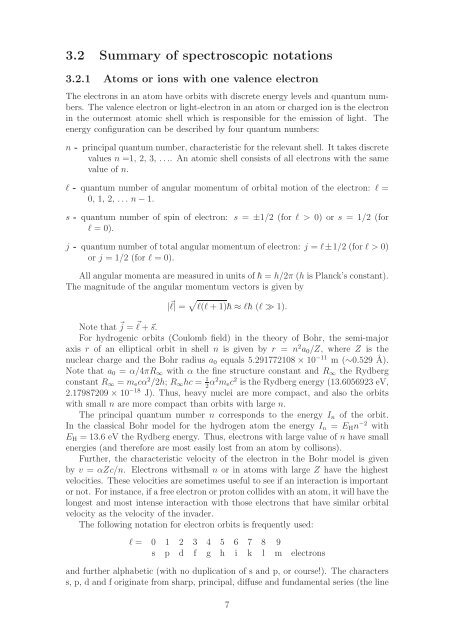Thermal X-ray radiation (PDF) - SRON
Thermal X-ray radiation (PDF) - SRON
Thermal X-ray radiation (PDF) - SRON
Create successful ePaper yourself
Turn your PDF publications into a flip-book with our unique Google optimized e-Paper software.
3.2 Summary of spectroscopic notations<br />
3.2.1 Atoms or ions with one valence electron<br />
The electrons in an atom have orbits with discrete energy levels and quantum numbers.<br />
The valence electron or light-electron in an atom or charged ion is the electron<br />
in the outermost atomic shell which is responsible for the emission of light. The<br />
energy configuration can be described by four quantum numbers:<br />
n - principal quantum number, characteristic for the relevant shell. It takes discrete<br />
values n =1, 2, 3, . . .. An atomic shell consists of all electrons with the same<br />
value of n.<br />
l - quantum number of angular momentum of orbital motion of the electron: l =<br />
0, 1, 2, . . . n − 1.<br />
s - quantum number of spin of electron: s = ±1/2 (for l > 0) or s = 1/2 (for<br />
l = 0).<br />
j - quantum number of total angular momentum of electron: j = l±1/2 (for l > 0)<br />
or j = 1/2 (for l = 0).<br />
All angular momenta are measured in units of = h/2π (h is Planck’s constant).<br />
The magnitude of the angular momentum vectors is given by<br />
| ⃗ l| = √ l(l + 1) ≈ l (l ≫ 1).<br />
Note that ⃗j = ⃗ l + ⃗s.<br />
For hydrogenic orbits (Coulomb field) in the theory of Bohr, the semi-major<br />
axis r of an elliptical orbit in shell n is given by r = n 2 a 0 /Z, where Z is the<br />
nuclear charge and the Bohr radius a 0 equals 5.291772108 × 10 −11 m (∼0.529 Å).<br />
Note that a 0 = α/4πR ∞ with α the fine structure constant and R ∞ the Rydberg<br />
constant R ∞ = m e cα 2 /2h; R ∞ hc = 1 2 α2 m e c 2 is the Rydberg energy (13.6056923 eV,<br />
2.17987209 × 10 −18 J). Thus, heavy nuclei are more compact, and also the orbits<br />
with small n are more compact than orbits with large n.<br />
The principal quantum number n corresponds to the energy I n of the orbit.<br />
In the classical Bohr model for the hydrogen atom the energy I n = E H n −2 with<br />
E H = 13.6 eV the Rydberg energy. Thus, electrons with large value of n have small<br />
energies (and therefore are most easily lost from an atom by collisons).<br />
Further, the characteristic velocity of the electron in the Bohr model is given<br />
by v = αZc/n. Electrons withsmall n or in atoms with large Z have the highest<br />
velocities. These velocities are sometimes useful to see if an interaction is important<br />
or not. For instance, if a free electron or proton collides with an atom, it will have the<br />
longest and most intense interaction with those electrons that have similar orbital<br />
velocity as the velocity of the invader.<br />
The following notation for electron orbits is frequently used:<br />
l = 0 1 2 3 4 5 6 7 8 9<br />
s p d f g h i k l m electrons<br />
and further alphabetic (with no duplication of s and p, or course!). The characters<br />
s, p, d and f originate from sharp, principal, diffuse and fundamental series (the line<br />
7
















